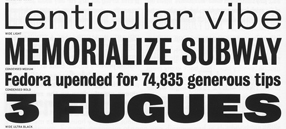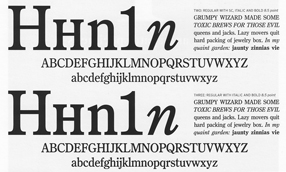When Eileen and I spent three weeks in Japan – the second half of August and the first week of September – we met several different groups of Japanese typographers, all of whom treated us wonderfully and extended their very generous hospitality.
The very first, the day after we arrived in Tokyo, was a small committee of people with a purpose: they are trying to establish legal protection for the design of typefaces in Japan. There has been, historically, no such legal protection, but they have some official interest – one of the three people I met with that day was from the Japan Patent Office – so perhaps they will actually be able to make something happen. At this point they’re collecting information about precedents in other countries. I described as well as I could the quixotic nature of the efforts in Europe and North America (it’s always an uphill battle, and a source of great frustration for anyone involved in designing typefaces), and offered to put them in touch with as wide a variety of knowledgeable people as I could. Two of the people I met with that day, Tomoko Nakatsuka, a researcher with the Institute of Intellectual Property, and a colleague of hers, later attended this year’s ATypI conference in Brighton, where they met with quite a few type designers, typographers, and others with a particular interest in this question.
Thanks to an introduction from Eiichi Kono, I also had coffee one afternoon with Reiko Tanihara, a young designer who had studied at the London College of Printing and had done her thesis on the mixing of the Latin alphabet and Japanese characters. I asked her a lot of questions about how a Japanese reader would perceive different kinds of typographic treatments, and learned a good deal about how the Latin alphabet fits into visual communication in Japan today. (I gather that the younger generations learn the Latin alphabet as just one more part of their very complex system of writing.)
During our later sojourn in Tokyo, after a week in Kyoto, Kanazawa, and the mountain villages of Gokayama, Eileen and I were the guests (along with science-fiction editor Ellen Datlow, our friend from New York, with whom we were traveling) of the Japan Typography Association, at an elaborate dinner at the Japan Publishing Club in the Kagurazaka neighborhood of Tokyo. It was a relatively formal but cheerful affair, with JTA members standing up and introducing themselves and their work, along with much general conversation; I had to get the gist of what they were saying through translation, since I speak no more than a few phrases of Japanese, and my own brief speech was translated in turn. One of the things I hoped to do was renew the existing ties between the JTA and ATypI. As I said to the JTA members, what I like best is making connections across boundaries, and linking Japanese and Western typographers is a large part of that.
I couldn’t begin to mention all the people I met at the JTA dinner. Kyoko Katsumoto, who organized the event, and Shigeru Fuse, who is on the Intellectual Property Right Committee, had kindly met us at our hotel and taken us by taxi to Kagurazaka. Most of the members were local, but Kyoko had come all the way from Osaka, a trip of several hours even by shinkansen. She showed us a catalog of digital typefaces that featured her own work; even without being able to read Japanese, I could appreciate the skill and artistry that went into some of those designs. One typeface, with a rounded, hand-carved look, managed to simultaneously echo ancient Chinese written forms from 2500 hundred years ago and reflect contemporary grunge-inspired display fonts – a startling, eclectic feat.
Two days later, after a lunchtime party at the publisher Hayakawa (which published Eileen’s book in Japan), we met up with Kiyonori Muroga, the editor-in-chief of Idea magazine, for whom I had written a short contribution to the special issue about Jan Tschichold. He took us back to the Idea offices – which looked very much like any magazine offices I’ve ever visited, a familiar clutter – then to the studio of the magazine’s designers, Shirai Design Studio, where we met a number of local designers and typographers, including Taro Yamamoto, Adobe’s main representative in Japan, whom I had conversed with by e-mail but had never met. Eileen had another commitment that evening in Yokohama, and had to leave early, but I went with Muroga-san and the rest to a fascinating little restaurant in the neighborhood, where I had a chance to try shochu, a strong, grappa-like distilled liquor that can apparently be made from any one of a bewildering variety of substances.
On our very last night in Japan, we visited Ginza (where, as Akira Kobayashi had put it to me in e-mail, “You will be standing at the most expensive quarter in Japan”) and met up with members of the Tokyo Type Directors Club, at the opening of an exhibit of work by Kenjiro Sano at the Ginza Graphic Gallery. We were introduced to the designer, and enjoyed what we saw of his work, but soon we were whisked off to another delightful restaurant and fed delicious morsels. (We ate extremely well in Japan, especially whenever we were with local people who knew the best places and the best dishes.) We met the flamboyant graphic designer Katsumi Asaba, who is president of Tokyo TDC and who presented me with not only several of his books but a set of three plates that he had designed (I worried about getting these back to Seattle safely, but they survived the journey just fine); Hiroko Sakomura, whom Matthew Carter describes as his “Japanese sister,” and with whom it turned out we had various unsuspected connections and mutual acquaintances; Takako Terunuma, who works with Asaba-san and organized the TDC evening; Masao Takaoka, who with his father Juzo is proprietor of a well-known letterpress printshop with a large, carefully chosen stock of Western foundry type; and several other local typographers. Also as guests at the dinner were two designers from Hong Kong, Teresa Chan and Benny Au Tak-shing, who were in Tokyo to work on a current project. I always enjoy this sort of cross-connection.
My memory for names, even in my own native language, is getting rather porous, so I especially appreciated the pervasive Japanese custom of exchanging meishi, or business cards. I suppose a more accurate translation would be “calling cards,” but these have long since fallen out of fashion in the West, where only in business settings do people routinely exchange cards (or even have them to exchange). I had arranged before we left to get new cards printed for both Eileen and myself, since I knew they would be expected. With the help of Eiichi Kono, who translated our English-language cards, I created a two-sided design that used the new ClearType screen-based font Meiryo, designed for Japanese Windows Vista, on the Japanese side of the card. Then I took the digital files to Day Moon Press, here in Seattle, where Maura Shapley had them turned into copper plates and printed them by letterpress onto stiff 2-point museum board. These made unusually thick but lightweight cards. Eiichi assured me that this would be the first time Meiryo was printed by letterpress. It was a particular pleasure to present them to some of the type designers from C&G who had worked on the creation of the Meiryo type family.
[Photos | Top: Tokyo main railway station. Middle: L–R, Shigeru Fuse, John Berry, Ellen Datlow, Eileen Gunn, Kyoko Katsumoto. Bottom: Kiyonori Muroga in middle (photo by Taro Yamamoto).]
Categorized as culture, events, type designers |


